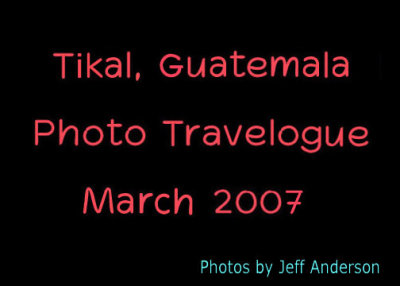
Tikal, Guatemala cover page. |
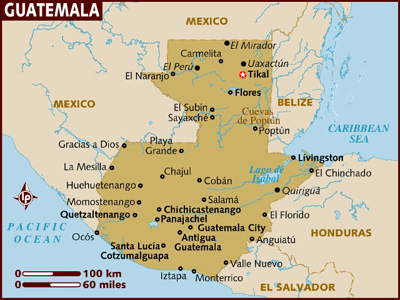
Map of Guatemala with the star indicating Tikal. |
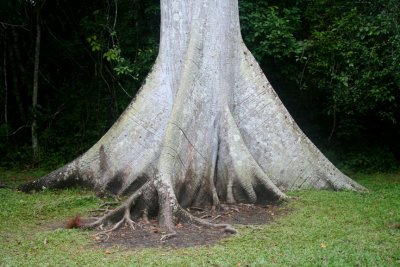
Base of the deciduous Ceiba tree. It's prevalent in Central America's tropical rain forests and reaches heights up to 70 meters. |
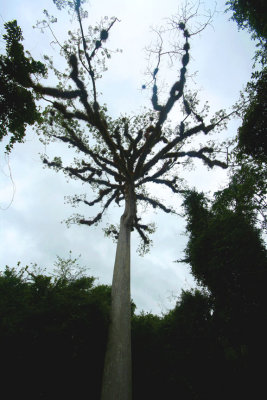
Top of the Ceiba tree which also has extensive and wide roots and which was declared "Guatemala's National Forest Tree." |

The first thing that I saw in Tikal was this one of the Twin Pyramids at Complex Q built by the ruler Chitam in 771 A.D. |

I made a point to climb every pyramid or temple possible in Tikal including this one at Complex Q. |

The view looking down from the top of the pyramid at Complex Q. |

The buildings at Complex Q were built to celebrate the end of a 20-year period, called a Katun, in the Maya Long Count calendar. |
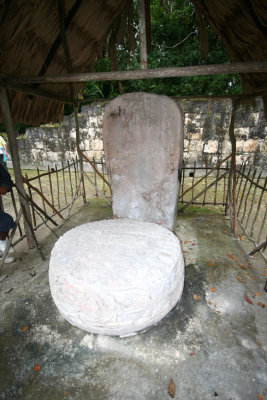
A stela (an upright stone or slab with an inscribed or sculptured surface) and altar at Complex Q. |

I saw this Ocellated Turkey on a trail in Tikal. I also heard, but did not photograph, an enraged Howler Monkey. |
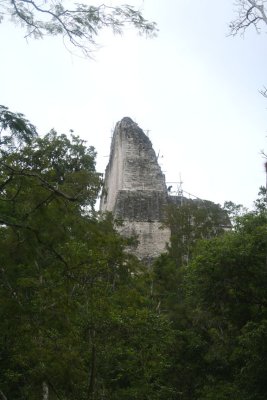
Temple IV is the highest temple in Tikal at 229 ft. and the highest structure in the Americas until the advent of skyscrapers. |

The daunting steps going up to Temple IV. The temple was built in 741 A.D. |

Temple IV is one of the tallest and most massive pre-Columbian structures in the Americas built by ruler Jasaw Chan K’awiil. |

Looking down the steps. The climb is not for those out of shape or for the feint of heart! |

Tourists standing at the top of Temple IV. Being the highest temple, the view is spectacular up there! |

Looking at the view of the rain forest below, it is hard to imagine that 1,200 years ago, the area was all agricultural. |

View of Temples I and II from the top of Temple IV in Tikal. |
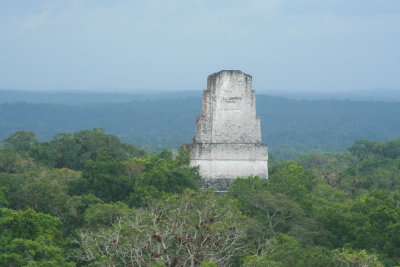
View of Temple III from the top of Temple IV in Tikal. |

View of Mundo Perdido (Lost World) from the top of Temple IV with a Ceiba tree to the left. |

That's me on top of Temple IV with Temples I, II and III in the background. |

Next, I went to Mundo Perdido (Lost World), which is believed to be the oldest complex in Tikal. Seen here is the big pyramid. |

Lost World was built and rebuilt, but it's earliest structures predate 500 B.C. making it likely the original center of Tikal. |
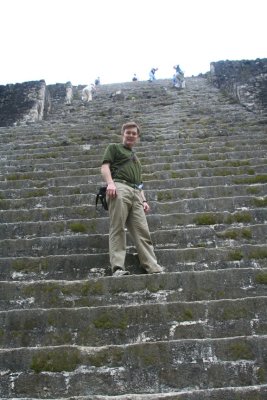
These steps were a real killer. They were among the few original steps (not wooden) that I was allowed to climb. |

Me on top of the Lost World pyramid. A smaller pyramid and Temple IV are in the background. |
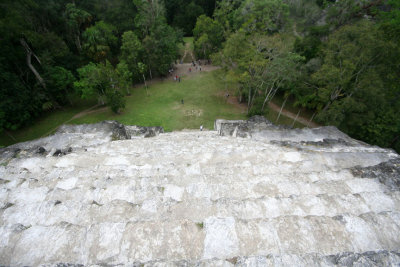
Looking down the steps from over 100 feet up. There are 4 stairways to the top, each flanked by massive stone masks. |

View from the top of the Lost World. The fact that it is flat on the top makes it distinctive from other Tikal temples. |

Close-up of the smaller pyramid as seen from as seen from the top of the big pyramid. |

Close-up of Temple IV as seen from as seen from the top of the Lost World. |

View of a Ceiba tree with Temple III (which is unexcavated) in the background. |

View of Temple III from ground level after I had climbed down from the Lost World. |

I was taken by this beautiful Ceiba tree set against the cloudy sky in Tikal. |

On the walk from the Lost World to the Great Plaza, I passed by these ruins of small pyramids in Tikal. |

The rear side of Temple II which is also known as the Temple of Masks. |

Seeing the Great Plaza and the steep wooden stairs Temple II for the first time was mind-blowing experience! |

It's believed Temple II was created by ruler Ah Cacau in 684 A.D. to honor his wife. Her tomb has not been found in it, though. |

View from the Temple of Masks of an almost identical temple in the Great Plaza, Temple I (the Temple of the Grand Jaguar). |

I couldn't resist climbing up those steep steps to the top! |

More views from Temple II onto the Great Plaza. In Mayan times, there was no grass. The Plaza was paved with limestone plaster. |

View towards the North Acropolis. Note the thatched roofs below. They protect massive relief sculptures underneath. |

This bird joined me at the top of the Temple II for the view of the Great Plaza. |
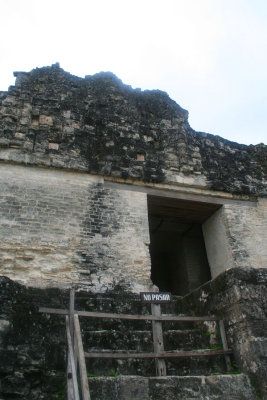
Roofcomb (window) on top of Temple II. Since there is very little space in the temples, they were mostly for religious use. |

View of the stairs as I climbed back down from Temple II. I prayed that the planks weren't rotten! |

View of Temple I from the North Acropolis. The tomb of ruler Jasaw Chan K’awiil I (682-734) lies under it at the plaza level. |

View of Temple II from the North Acropolis. These temples are also endowed with incredible acoustics. |

In Mayan times, the accoustics were so good, one could speak in a normal voice and be heard between the tops of the two temples. |

Panoramic view of the Great Plaza with Temple I and the Temple II on the right and left. In Mayan times, they were painted red. |

Interior view inside the North Acropolis. It is composed of structures built on top of each other starting as early as 400 B.C. |

North Acropolis was chosen for the burial ground of the rulers of Tikal for over 5 centuries between 1 A.D. and 550 A.D. |

Archeologists believe that North Acropolis (and Lost World) are the most ancient areas where the first settlers came to Tikal. |

In Mayan times, North Acropolis was painted in brilliant colors, looking very different from the bare rock we see today. |

The Central Acropolis is the fourth series of structures that surround the Great Plaza. |

The series of small rooms and terraces in Central Acropolis are thought to be ceremonial areas and storage for artifacts. |

An abundance of ancient graffiti covers the interior walls of the Central Acropolis depicting the gods and ancient events. |

It was the likely viewpoint for the nobles to watch the games of the renowned ball courts. One of them is visible near Temple I. |
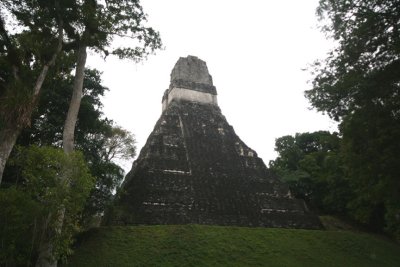
Rear view of Temple I (the Grand Jaguar Temple) as I was leaving the Great Plaza. |
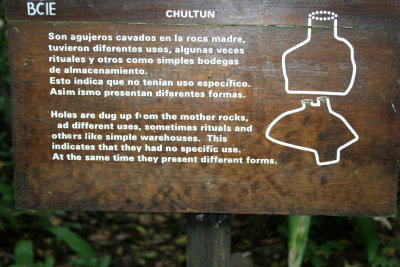
A sign in Tikal describing a chultun (a bottle-shaped cistern built underground by the ancient Mayans). |

This hole could have been used by the Mayans for anything from storage to religious rituals. |

Pathway leading to the Late Classical Group G, which forms one of the largest clusters of major palace construction at Tikal. |
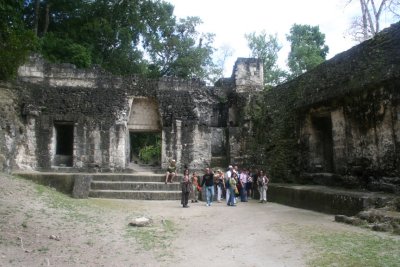
Group G is associated with the Late Classic ruler Yik’in Chan Kawil. Group G may have been his private palace quarters. |

Yik’in Chan Kawil was an even more prodigious builder than his father, Jasaw Chan K’awiil. Yik’in constructed Temples IV and VI. |

Me standing in front of a narrow passageway in the Group G complex in Tikal (also known as Palacio de las Acanaladuras). |
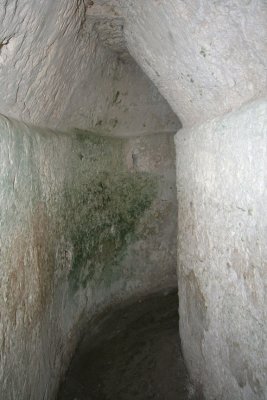
Another narrow passageway. Group G has an aisle vault leading to an inner court of 2 floors. |

Me posing again at Group G. |

I climbed up to the top of the Group G and took this picture looking down from it. |

Door leading to a tunnel under Group G, which contained some hieroglyphics painted on plaster. The door is not original |

View of Temple V coming from behind, my next destination after leaving Group G. |

Photo showing Temple V before it was renovated. It was covered by the rainforest growth. |

Photo showing Temple V after it was renovated. This is how it looked when I saw it. |
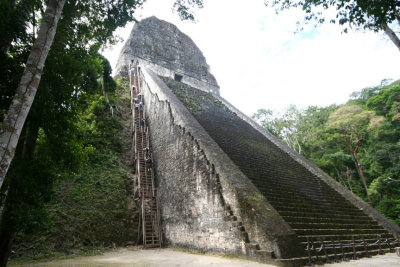
At 59 meters (190 ft.), Temple V is the second tallest temple at Tikal. It's believed to be the burial site of an unknown ruler. |

Temple V was recently restored. It's thought that it was commissioned and built by the ruler Animal Skull in 600 A.D. |
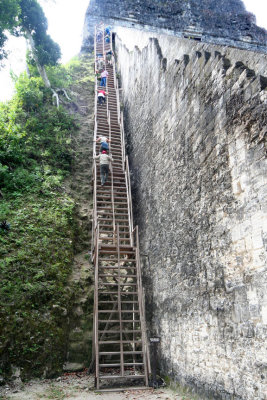
In my opinion, the stairs going up Temple V are the most nerve-wracking in all of Tikal! |
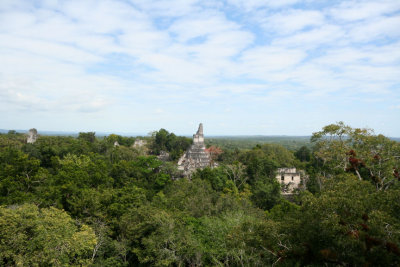
View from the top of Temple V of the rainforest below and (what I believe is) Temple I. |

View looking directly down from Temple V. You can see how steep it was. |

The ledge on top of Temple V was narrow. The last death in Tikal was a photographer who stepped back too far! |

Looking down the precipitous stairs of Temple V. It was tortuous to get up them! |

View of some other tourists who were adventurous enough (or insane enough) to go to the top of Temple V with me. |

That's me on top of Temple V. I believe that's Temple I behind me since we were facing the Great Plaza. |

A closer view of what I believe was Temple I (as seen from the top of Temple V). |

View of a Ceiba tree and the rain forest from the top of Temple V. |

This workman, who was doing excavation work near the Plaza of the Seven Temples, let me snap his picture. |
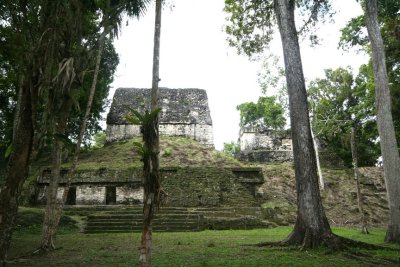
My next stop was the Plaza of the Seven Temples, east of the Plaza of the Great Pyramid, dating from the Preclassic Period. |

It's called Seven Temples because of the seven Late Classic Period temples there which were among the most attractive in Tikal. |

The Plaza of the Seven Temples is currently undergoing a major excavation and restoration which has many more years to go. |

Plaza of the Seven Temples is unique because it contained 3 Mayan ballfields where the Mayan ball game (named Pitz) was played. |
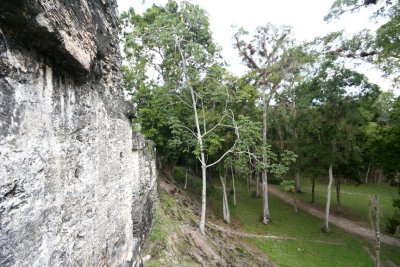
It was the first sport in the history of the humankind, dating from at least 2500 B.C. |
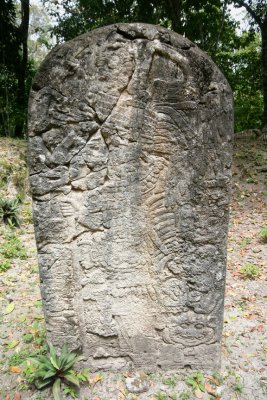
After leaving the Plaza of the Seven Temples, I saw this ancient Mayan alter. |

My very last stop in Tikal was the Twin Pyramid Complex P. Many sculptures and carvings were found in Complex P. |
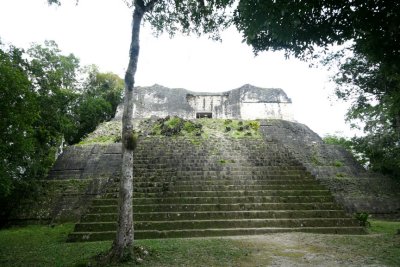
Yik'in, son of ruler Jasaw Chan K’awiill, built Twin Pyramid Complex P to celebrate the end of the the Katun on May 7, 751 A.D. |

However, a temple in the complex dates earlier to around 530 A.D. (a Katun is a 20-year cycle in the Maya Long Count calendar). |

I got nervous when I climbed to the top of this pyramid, because several black vultures were waiting for me! |

Close-up of one of the black vultures on top of the Twin Pyramid Complex P. |

To the vultures' dismay, I didn’t fall off this Complex P ledge. They’ll have to wait for another tourist for their next meal! |











